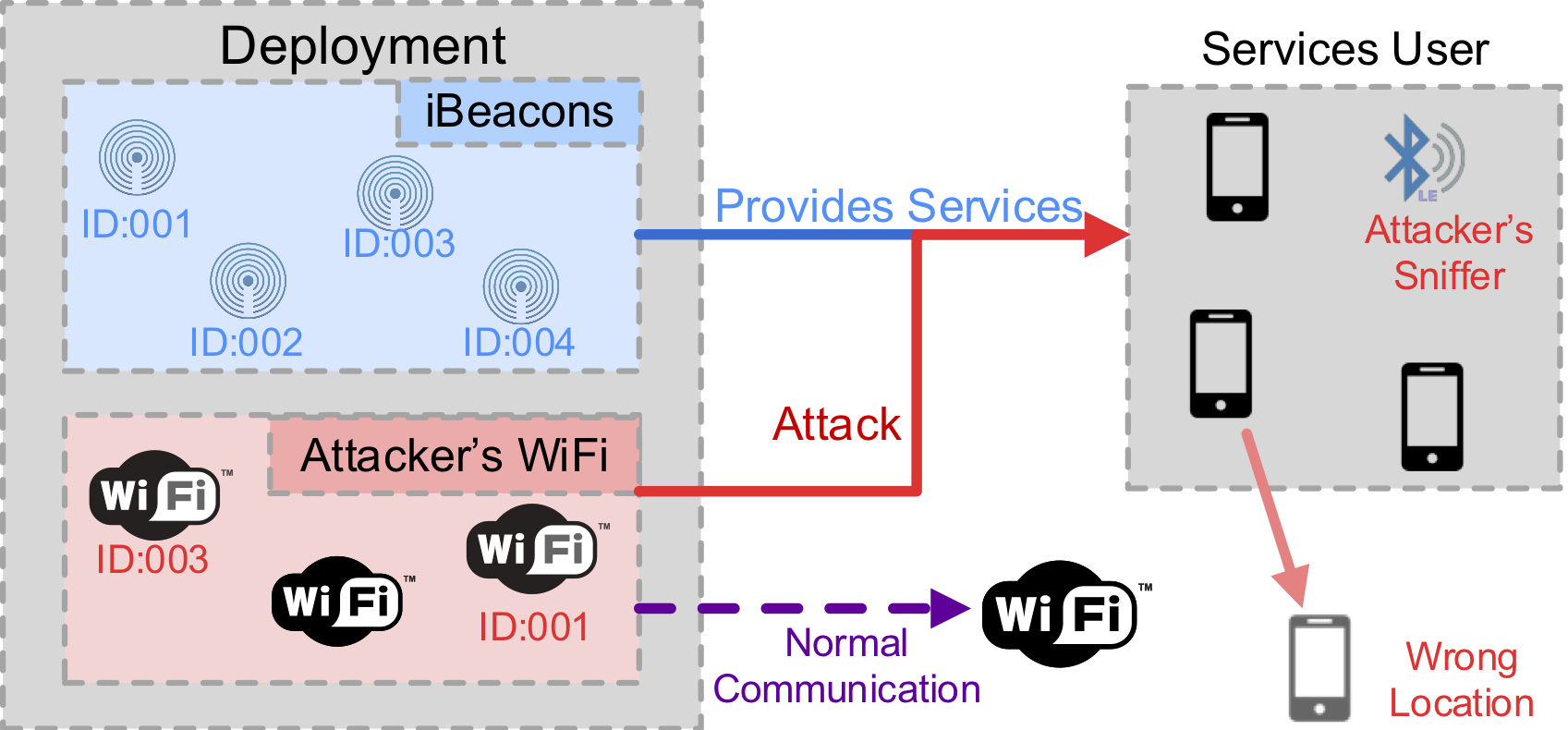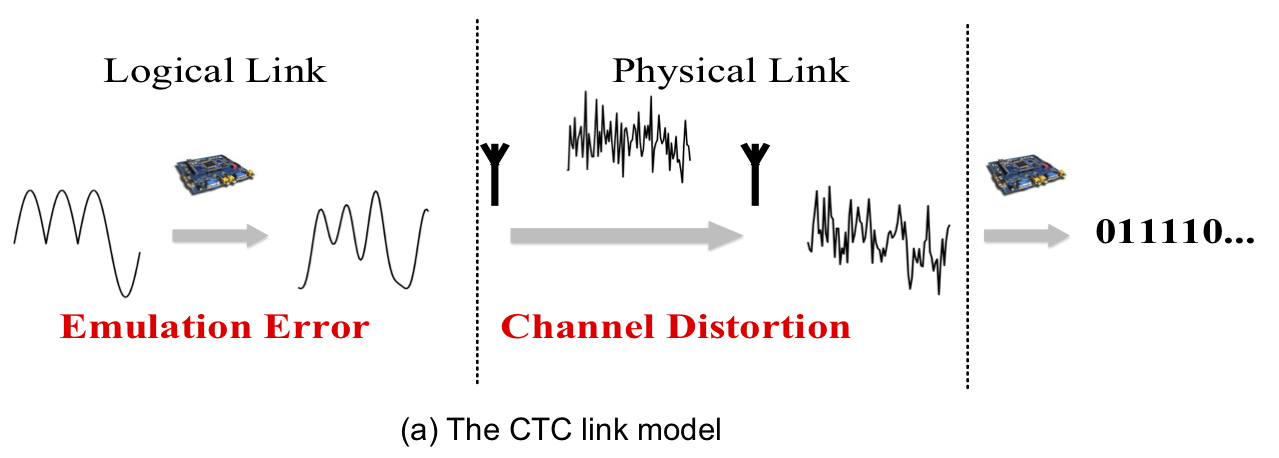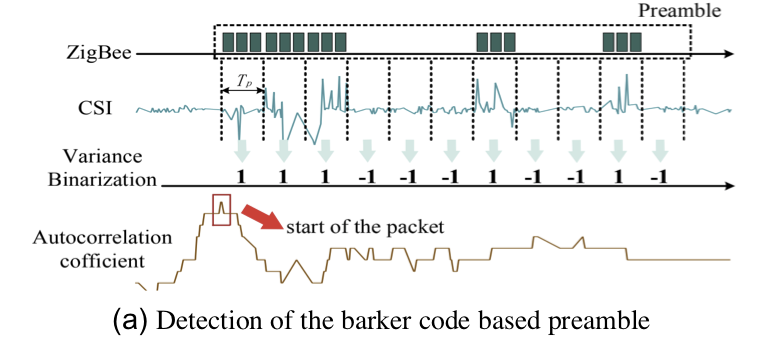Researches
Cross-Technology Communication
ZigFi: Harnessing Channel State Information for Cross-Technology Communication

Over the last decade,we have witnessed the explosive growth of wireless technologies in diversity (e.g., WiFi, ZigBee, and Bluetooth) as well as in density, to satisfy various communication and service requirements under different environments. Under the highly diversified and dense wireless habitat, the connectivity between specialized heterogeneous wireless technologies offers a great opportunity for advanced services. To this end, researchers recently propose cross-technology communication (CTC) technique which enables direct connection between heterogeneities only using commodity devices. In this paper, we propose ZigFi, a novel CTC from ZigBee to WiFi. ZigFi deliberately overlaps ZigBee packets with WiFi packets and Channel State Information (CSI) is used to convey data. Evaluation results demonstrate that ZigFi achieves a throughput of 215.9bps, which is 18x faster than the state-of-the-art approach. This work appears in ToN 2020 and INFOCOM 2018.
Resources
- Paper: ZigFi: Harnessing Channel State Information for Cross-Technology Communication
- Slides: ZigFi Slides
- DataSet: ZigFi Dataset
WIDE: Physical-level CTC via Digital Emulation

Recent works achieve physical-level CTC by emulating the standard time-domain waveform of the receiver. This method faces the challenges of inherent unreliability due to the imperfect emulation. Different from analog emulation, we propose a novel concept named digital emulation, which stems from the following insight: The receiver relies on the phase shift to decode symbols rather than the shape of analog time-domain waveform. There are lots of phase sequences which satisfy the requirement of phase shift. The distortions of these phase sequences after WiFi emulation are different. We have the opportunity to select an appropriate phase sequence with the relatively small emulation errors to achieve a reliable CTC. We implement our proposal as WIDE, a physical-level CTC via digital emulation from WiFi to ZigBee. Evaluation results show that WIDE significantly improves the Packet Reception Ratio (PRR) from 41.7% to 86.2%, which is 2× of WEBee’s, an existing representative physical-level CTC. This work appears in IPSN 2019.
Resources
- Paper: WIDE: Physical-level CTC via Digital Emulation
- Slides: WIDE Slides
- DataSet: WIDE DataSet
LEGO-Fi: Harnessing Channel State Information for Cross-Technology Communication

Existing physical-level CTC means considerable processing complexity at the transmitter, which doesn't apply to the communication from a low-end transmitter to a high-end receiver, e.g. from ZigBee to WiFi. This paper presents transmitter-transparent cross-technology communication, which leaves the processing complexity solely at the receiver side and therefore makes a critical advance toward bidirectional high-throughput CTC. We implement our proposal as LEGO-Fi, the communication from ZigBee to WiFi. The key technique inside is cross-demapping, which stems from two key technical insights: (1) A ZigBee packet leaves distinguishable features when passing the WiFi modules. (2) Compared to ZigBee’s simple encoding and modulation schemes, the rich processing capacity of WiFi offers extra flexibility to process a ZigBee packet. The evaluation results show that LEGO-Fi achieves a throughput of 213.6Kbps, which is respectively 13000× and 1200× faster than FreeBee and ZigFi, the two existing ZigBee-to-WiFi CTC approaches. This work appears in INFOCOM 2019.
Resources
WiZig: Harnessing Channel State Information for Cross-Technology Communication

In order to achieve CTC, existing packet-level proposals try to exploit free side-channels as information carriers. Regarding the wireless medium, a side channel typically exists in the following three dimensions: frequency, amplitude, and time. By exploiting a side-channel like frequency, amplitude or time, the existing works enable CTC but have limited performance under channel noise. In this paper, we propose WiZig, a novel CTC technique that employs modulation techniques in both the amplitude and temporal dimensions to optimize the throughput over a noisy channel. We establish a theoretical model of the energy communication channel to clearly understand the channel capacity. We then devise an online rate adaptation algorithm to adjust the modulation strategy according to the channel condition. The evaluation results show that WiZig achieves a throughput of 153.85bps with less than 1% symbol error rate in a real noisy environment. This work appears in INFOCOM 2017.
Resources
Stripcomm: Harnessing Channel State Information for Cross-Technology Communication

Existing packet-level CTCs based on amplitude modulation are not reliable in the coexisting environments. Although CTC can be free from the interference in the senders communication range by using RTS/CTS to reserve the channel, it is still easy for other ambient devices to introduce serious performance degradation of CTC. Considering the practice of IoT applications, how to make CTC resilient to interference is still an open problem. We propose StripComm, a novel CTC technique interconnecting WiFi and ZigBee devices in coexisting environments. We design a new interference-resilient modulation mechanism that encodes symbols by the changes of packet presence and absence to avoid the fallibility of the single state. We devise an interference-aware decoding mechanism that strips out the interference based on the distinguishable RSS patterns caused by the self-similarity of StripComm signals. The throughput of StripComm is 1.1Kbps with SER lower than 0.01 in a real office environment, and still 0.89Kbps even under strong interference.This work appears in INFOCOM 2018.
Resources
Wi-attack: Cross-technology Impersonation Attack against iBeacon Services

iBeacon protocol is widely deployed to provide location-based services. By receiving its BLE advertisements, nearby devices can estimate the proximity to the iBeacon or calculate indoor positions. However, the open nature of these advertisements brings vulnerability to impersonation attacks. Such attacks could lead to spam, unreliable positioning, and even security breaches. In this paper, we propose Wi-attack, revealing the feasibility of using WiFi devices to conduct impersonation attacks on iBeacon services. Different from impersonation attacks using BLE compatible hardware, Wi-attack is not restricted by broadcasting intervals and is able to impersonate multiple iBeacons at the same time. Effective attacks can be launched on iBeacon services without modifications to WiFi hardware or firmware. To enable direct communication from WiFi to BLE, we use the digital emulation technique of cross technology communication. To enhance the packet reception along with its stability, we add redundant packets to eliminate cyclic prefix er- ror entirely. The emulation provides an iBeacon packet reception rate up to 66.2%. We conduct attacks on three iBeacon services scenarios, point deployment, multilateration, and fingerprint- based localization. The evaluation results show that Wi-attack can bring an average distance error of more than 20 meters on fingerprint-based localization using only 3 APs. This work appears in IEEE SECON 2021.
Resources
- Paper: Wi-attack: Cross-technology Impersonation Attack against iBeacon Services
- Slides: Wi-attack Slides
- Source code: Wi-attack Implementation
CLQI: Link Quality Estimation of Cross Technology Communication

Research on Cross-technology communication (CTC) has made rapid progress in recent years, but how to estimate the quality of a CTC link remains an open and challenging problem. Through our observation and study, we find that none of the existing approaches can be applied to estimate the link quality of CTC. Built upon the physical-level emulation, transmission over a CTC link is jointly affected by two factors: the emulation error and the channel distortion. We in this paper propose a new link metric called C-LQI and a joint link model that simultaneously takes into account the emulation error and the channel distortion in the process of CTC. We further design a light-weight link estimation approach to estimate C-LQI and in turn the PRR over the CTC link. We implement C-LQI and compare it with two representative link estimation approaches. The results demonstrate that C-LQI reduces the relative error of link estimation respectively by 46% and 53% and saves the communication cost by 90%. This work appears in INFOCOM 2020.
Resources
- Paper: CLQI: Link Quality Estimation of Cross Technology Communication
- Slides: CLQI Slides
- Source code: CLQI Implementation
Crocs: Cross-Technology Clock Synchronization for WiFi and ZigBee

IoT systems nowadays often involve heterogeneous wireless devices with totally different standards. How to conduct clock synchronization directly between these devices without gateway is promising but challenging. We propose Crocs to synchronize ZigBee and WiFi devices by cross-technology communication without extra hardware cost. Crocs decouples the synchronization signal from the transmission of a timestamp. By incorporating a barker-code based beacon, Crocs aligns a global time for ZigBee and WiFi. Then we enable the timestamp exchange between WiFi and ZigBee by cross-technology transmission, e.g., temporal modulation. Crocs achieves robust and accurate synchronization among WiFi and ZigBee devices, with the synchronization error lower than 1 millisecond. This work appears in EWSN 2018.
Resources
AdaComm: Tracing Channel Dynamics for Reliable Cross Technology Communication

Much research on Cross-Technology Communication (CTC) in recent years has mainly focused on how to enable CTC. The reliability of CTC, however, is equally important and has seldom been studied before. To fill this gap, we present AdaComm, a generic framework to achieve self-adaptive CTC in time-varying channels. Different from traditional wireless technologies which adapt to channels passively by switching date rate of transmitters, AdaComm adopts online learning mechanism to actively adjust the decoding model at the CTC receiver. The decoding model automatically learns the most effective features directly from the raw received signals, thus improving the decoding accuracy of the receiver. The evaluation results demonstrate that AdaComm significantly reduces the SER (symbol error rate) by 72.9%. This work appears in SECON 2019.